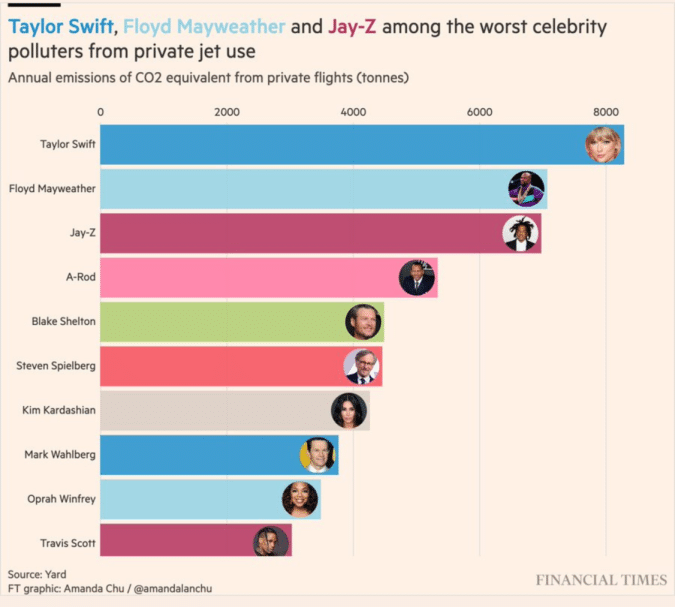Pop sensation Taylor Swift, owner of a $40 million private jet, is making headlines as she turns to carbon offsets to address her substantial carbon footprint. Despite being the world’s most carbon polluting celebrity in 2022, Swift aims to offset her emissions.
However, questions arise about the transparency and legitimacy of these carbon offsets, raising concerns within the climate-conscious community.
Carbon offsets are mechanisms used by companies and individuals to compensate for their carbon emissions by investing in projects that reduce or remove an equivalent amount of greenhouse gasses (GHG). Each offset equals one tonne of carbon emissions.
Private Jets and Celebrity Carbon Footprints
The aviation industry contributes about 2.5% of global emissions. Despite airplanes emitting around 100x more carbon dioxide per hour than other transportation modes, celebrities like Taylor Swift seldom opt for public transport.
The pop star’s reliance on a private jet significantly amplifies her carbon footprint compared to an average individual.
Private jets are considered the most polluting form of transport, posing challenges in global decarbonization efforts.
In the U.S., a study by the Institute for Policy Studies (IPS), showed that the richest 1% of air travelers in the country are responsible for about 50% of all aviation carbon emissions.
In the UK, each of the wealthy fliers onboarding largest private jets release as much as 20-30x more pollution than those flying in economy class on ordinary commercial flights. These flights are several times more polluting than transit.
Celebrities and politicians, in particular, receive criticisms from environmentalists regarding their carbon footprints, which are higher than that of the average person.
Putting that in perspective, a flight from London to Dubai makes a private jet 11x more polluting than a regular commercial aircraft, 35x more than a train, and a whopping 52x more than a bus.
Jet-Set Stats: Unveiling Swift’s Sky-High Carbon Footprint
According to a digital sustainability consultancy, Yard, Taylor Swift is the world’s most carbon polluting celebrity due to her footprint in 2022. She is followed by Floyd Mayweather and Jay-Z.
The study revealed that only 15% of the population takes 70% of the flights annually. It also showed that the average CO2 emissions by the celebrities surveyed, through their private jet flights alone, stands at 3,376.64 tonnes each. In comparison, an average person emits only 7 tonnes of carbon every year.
Of the celebrities studied, the pop princess tops the list for 2022. With a staggering total of 170 flights since January, Swift’s jet has logged an extensive 22,923 minutes in the air. That’s roughly 16 days in total.
This substantial figure is noteworthy, especially considering that she’s not on tour that period. Her jet’s average flight duration is a mere 80 minutes, covering an average distance of over 139 miles per flight.
Swift’s cumulative flight emissions for the year reach 8,293.54 tonnes, representing a staggering >1,100x more than the average person’s total annual emissions. Her shortest recorded flight for 2022 was a brief 36 minutes, covering the distance from Missouri to Nashville.
Swift’s Bid for Environmental Redemption
In the middle of her Eras Tour in March 2023, Swift’s regular flights to see her NFL-playing boyfriend, Travis Kelce, emitted 138 tonnes of CO2 in 3 months. The superstar remains the world’s most carbon emitting celebrity.
In an Instagram post tracking Swift’s private jet flight records, she took 12 flights to see her love interest. These flights by her Desault Falcon 7x and Dessault Falcon 900 emitted a total of 138 tonnes of CO2. That means the popular singer can offset that footprint by growing almost 2,300 trees for a decade.
However, the pop star’s representative said that Taylor’s private jet is also loaned out to others, so it’s incorrect to attribute most or all of the trips to her. The spokesperson further noted that “Taylor purchased more than double the carbon credits needed to offset all tour travel.”
Carbon offsets are generated by projects or initiatives that reduce or capture carbon dioxide from the atmosphere. It could be through natural ecosystems or using carbon removal or carbon capture technologies.
From which project do carbon offsets Taylor Swift purchased come from?
Individuals or corporations are not required to publicly disclose their sources of carbon offsets. But as the carbon credit industry is strengthening its integrity and reliability, regulations are also tightening. Transparency in reporting and disclosing carbon offsets, despite being voluntary, would soon be the standard.
Universal, Swift’s record label, didn’t disclose where the singer had bought the offsets. These offsets, including those bought by corporations, undergo verification by third parties to ensure reliability and effectiveness.
Controversies surround the validity of offsets after an expose last year claimed that 90% of them approved by the leading verification body, Verra, were worthless. Verra disputed that the allegations aren’t valid.
The legitimacy of Taylor Swift’s offsetting her carbon footprint may remain uncertain. Despite this ambiguity, Swift appears determined to shed her climate villain reputation. Whether the pop princess will eventually disclose the details is unclear, but her move brings celebrity carbon accounting to the forefront.



